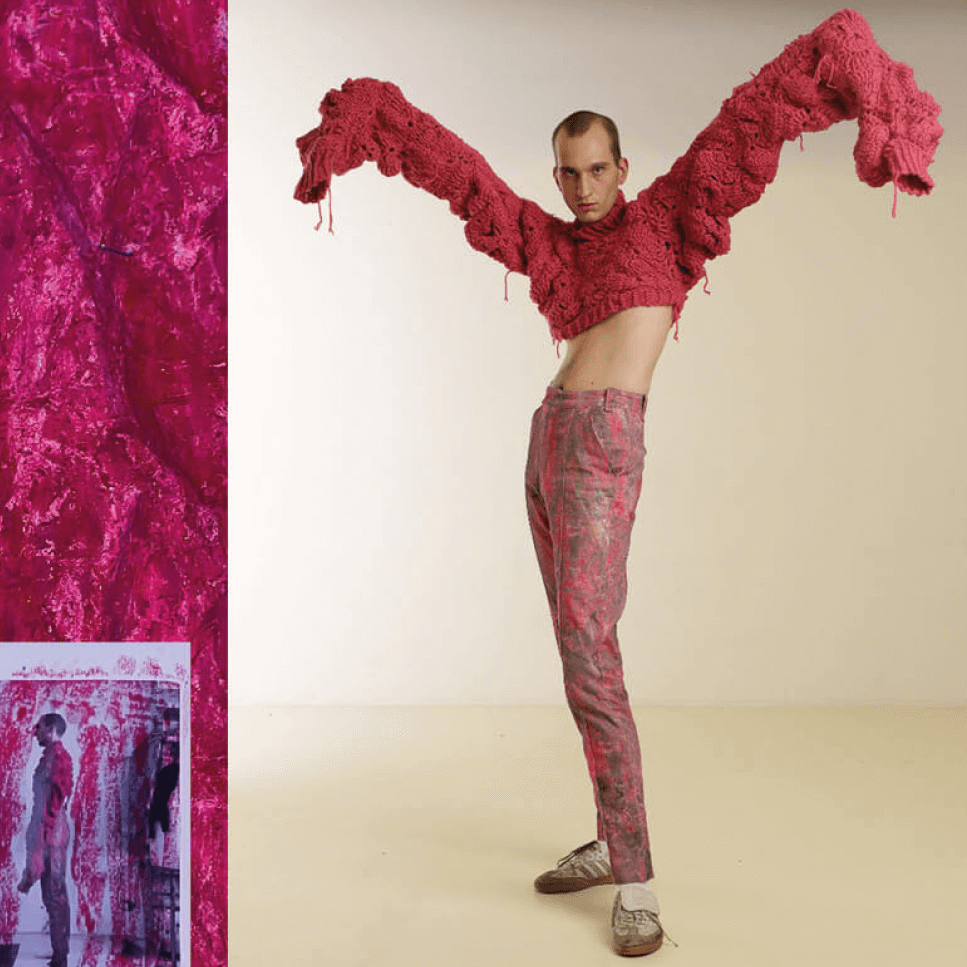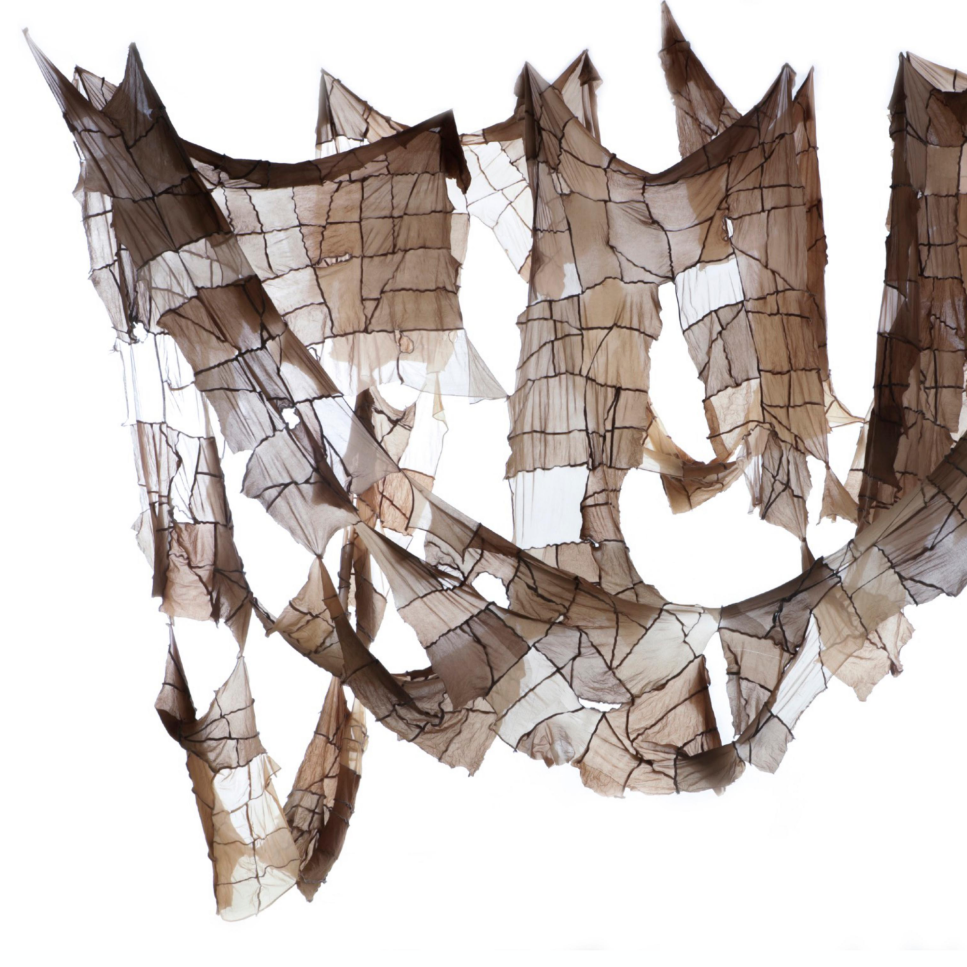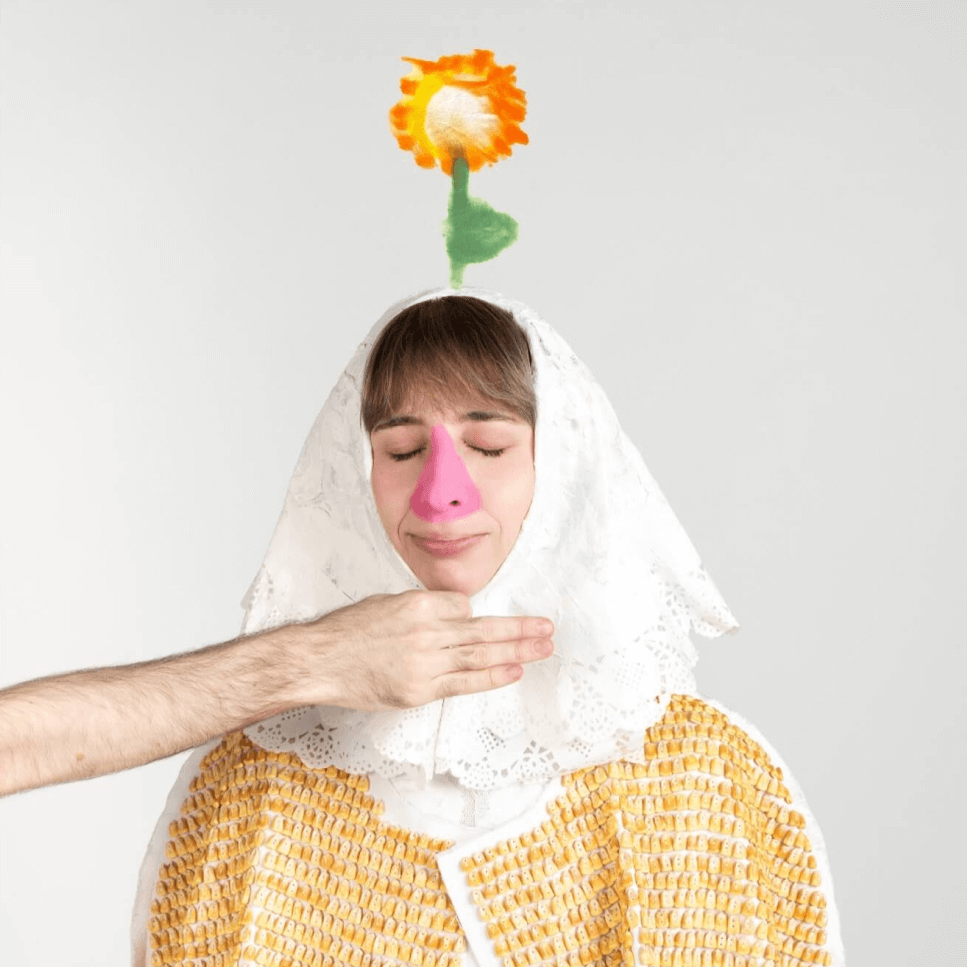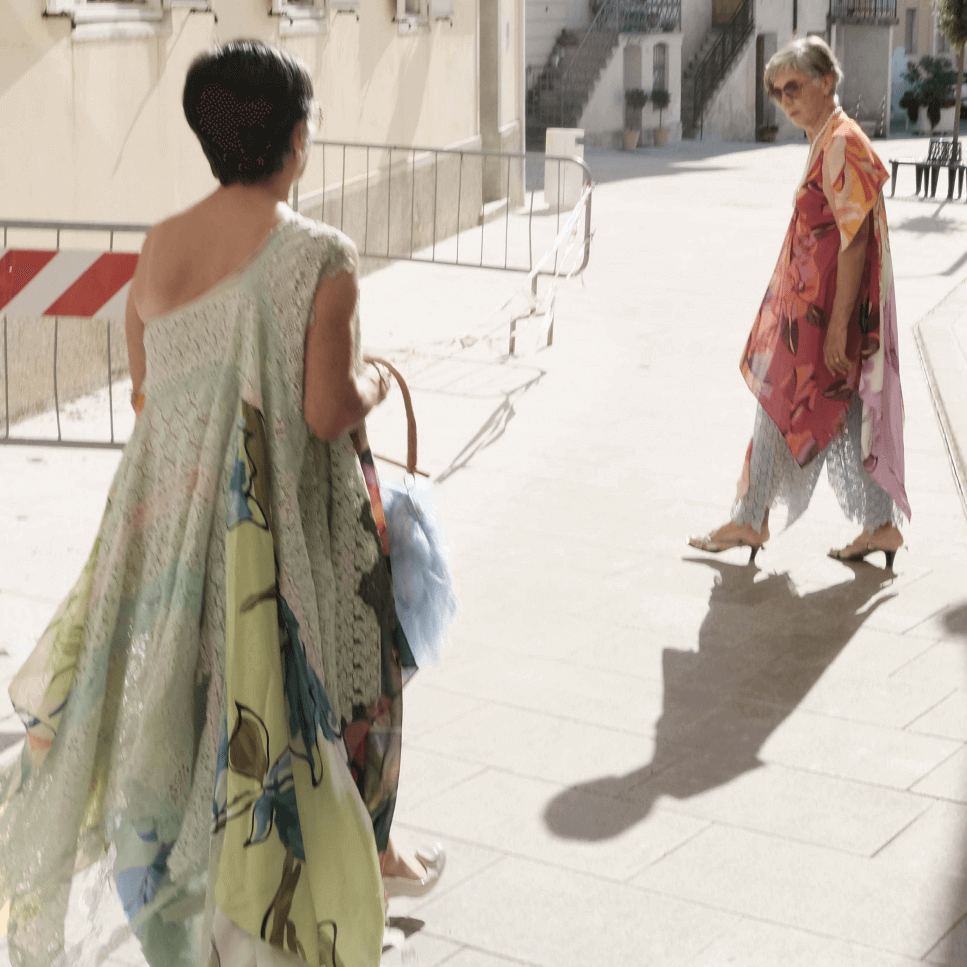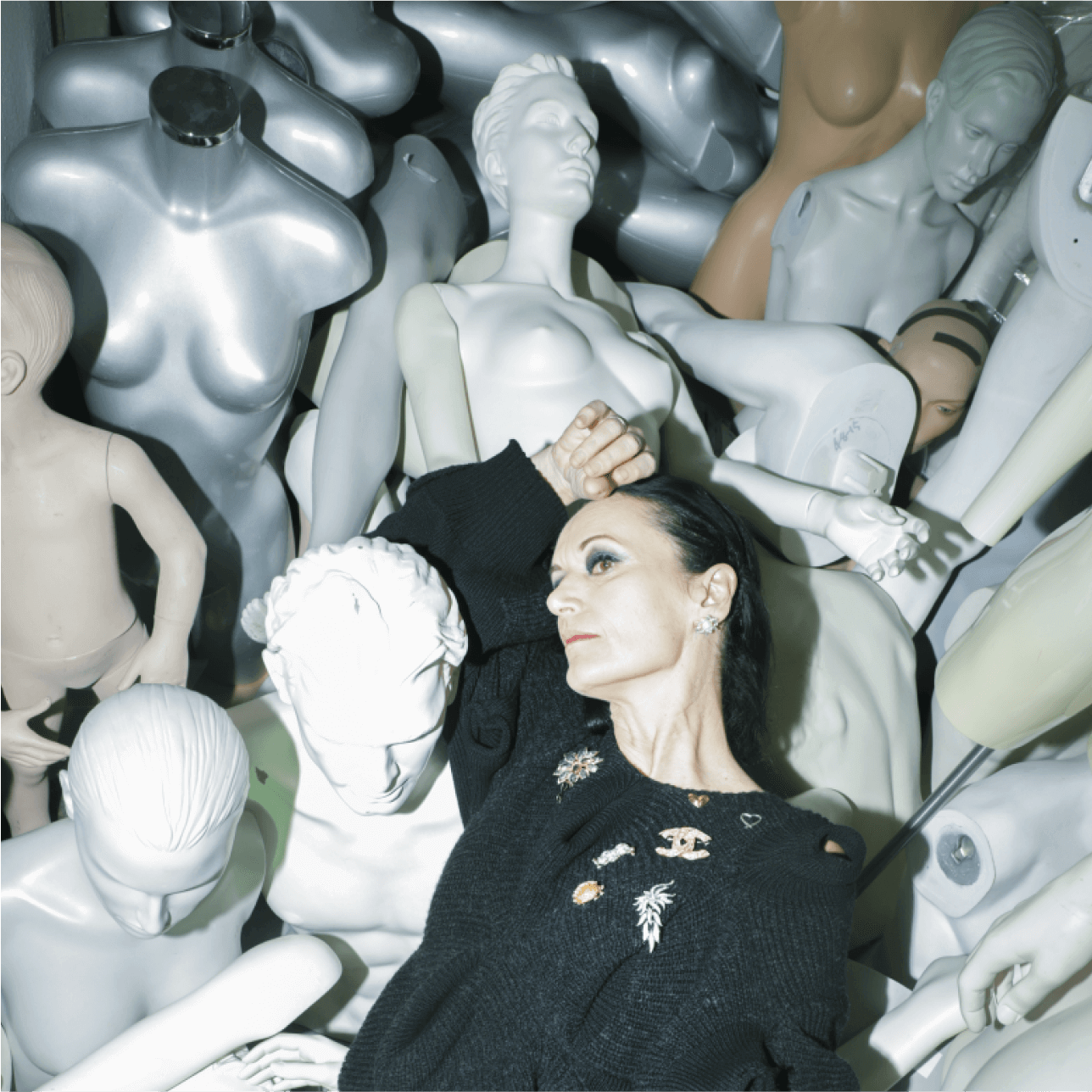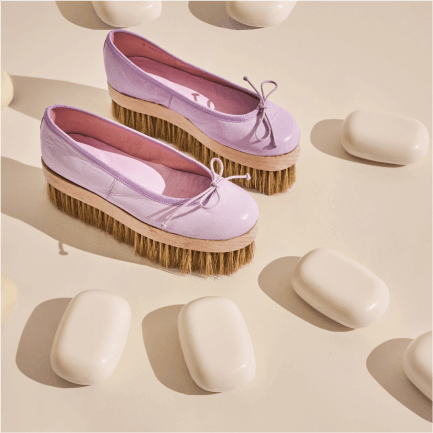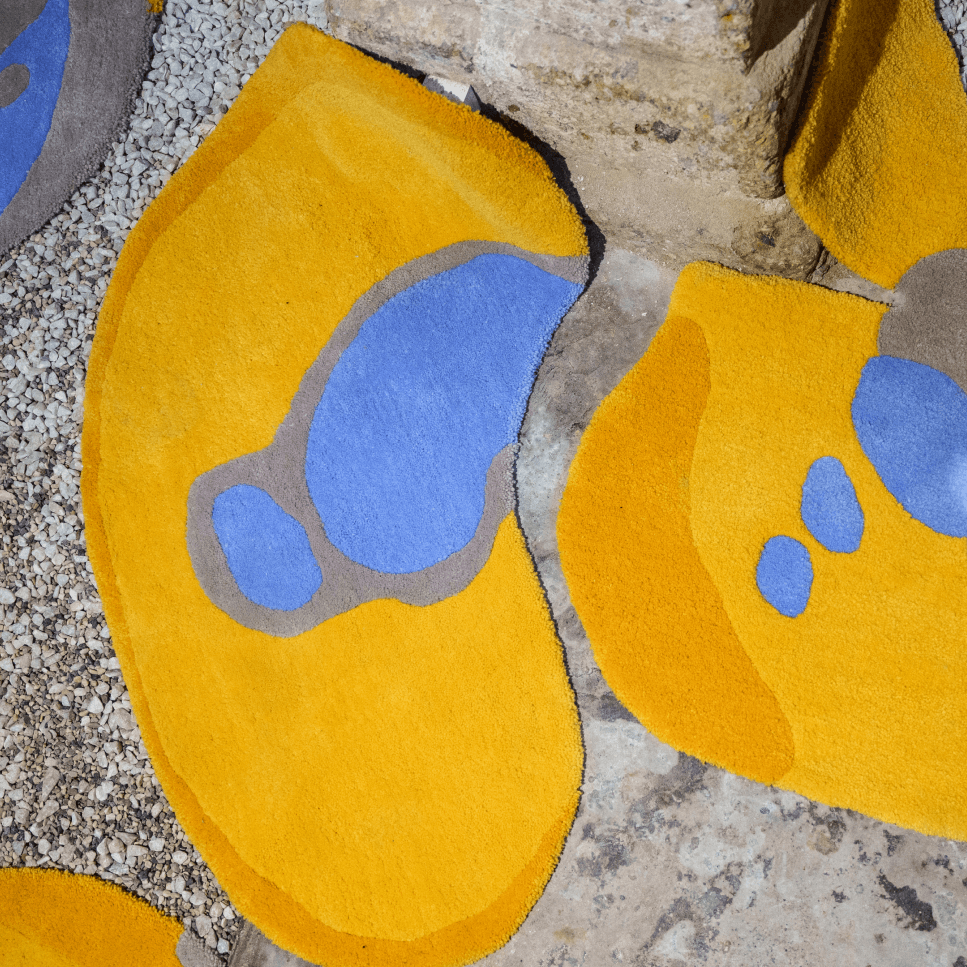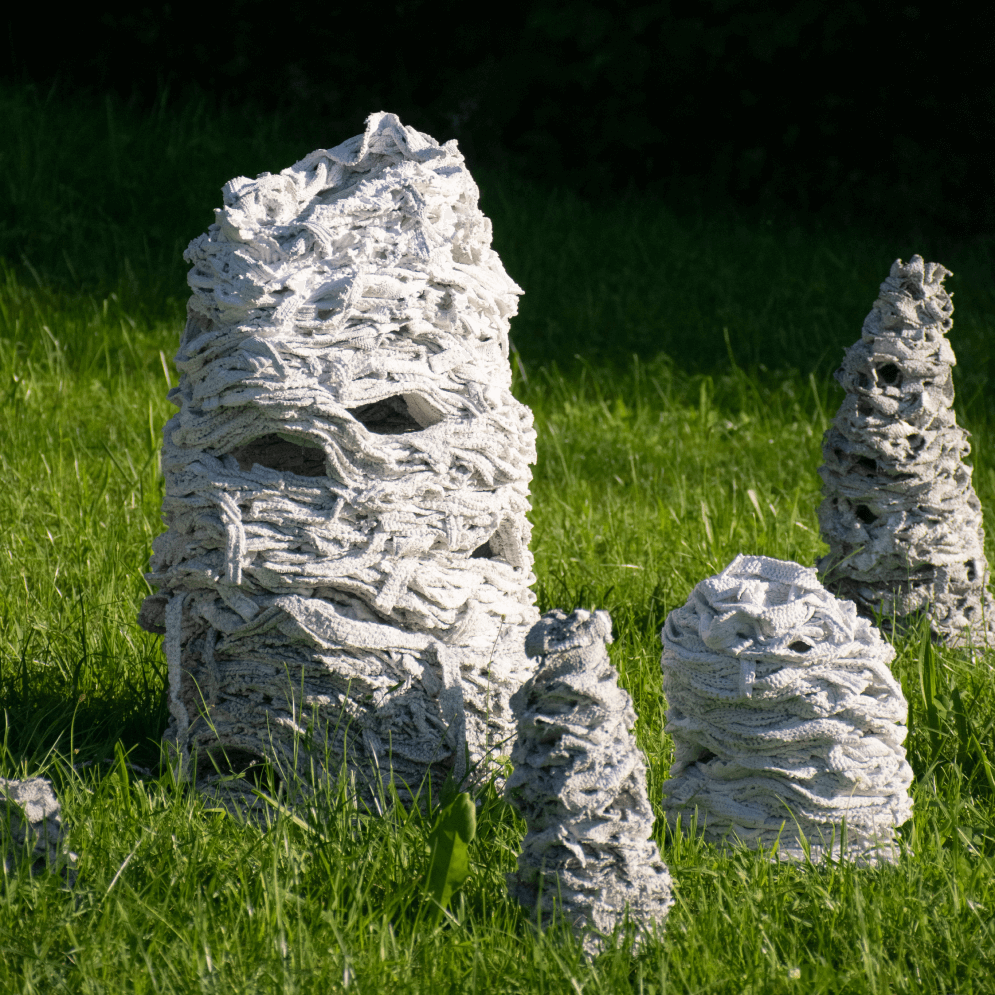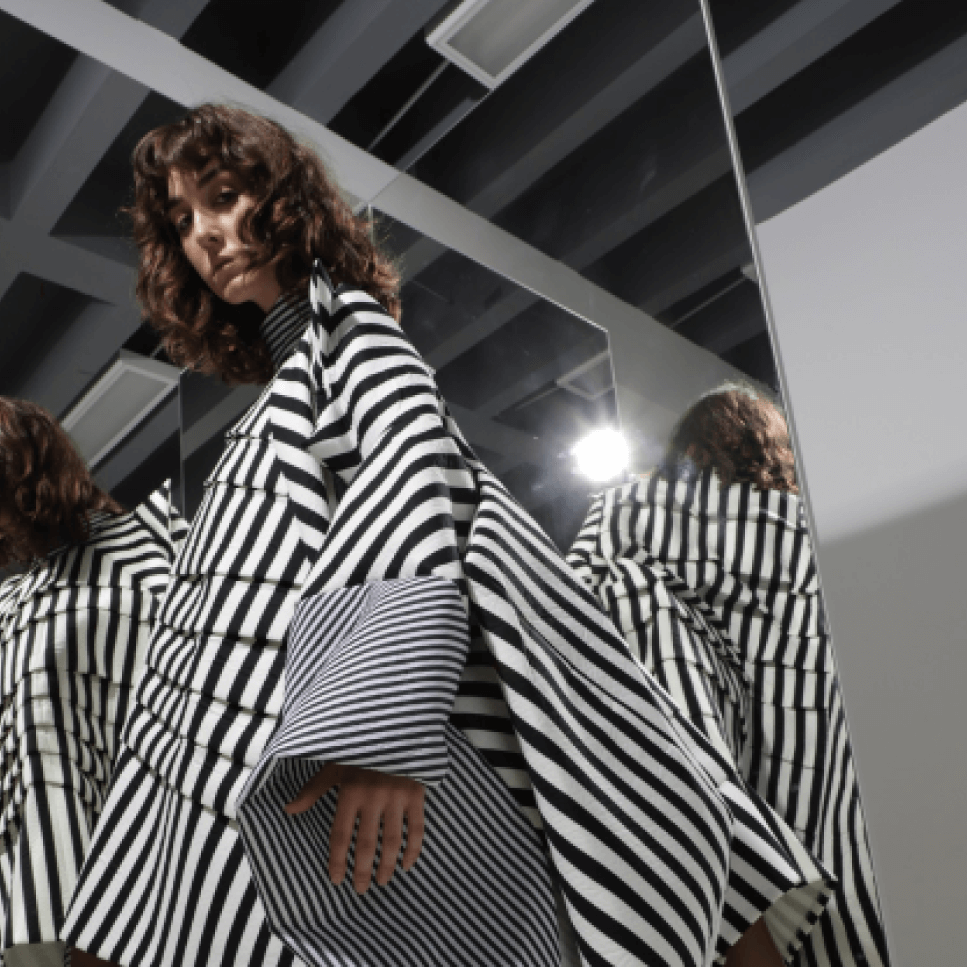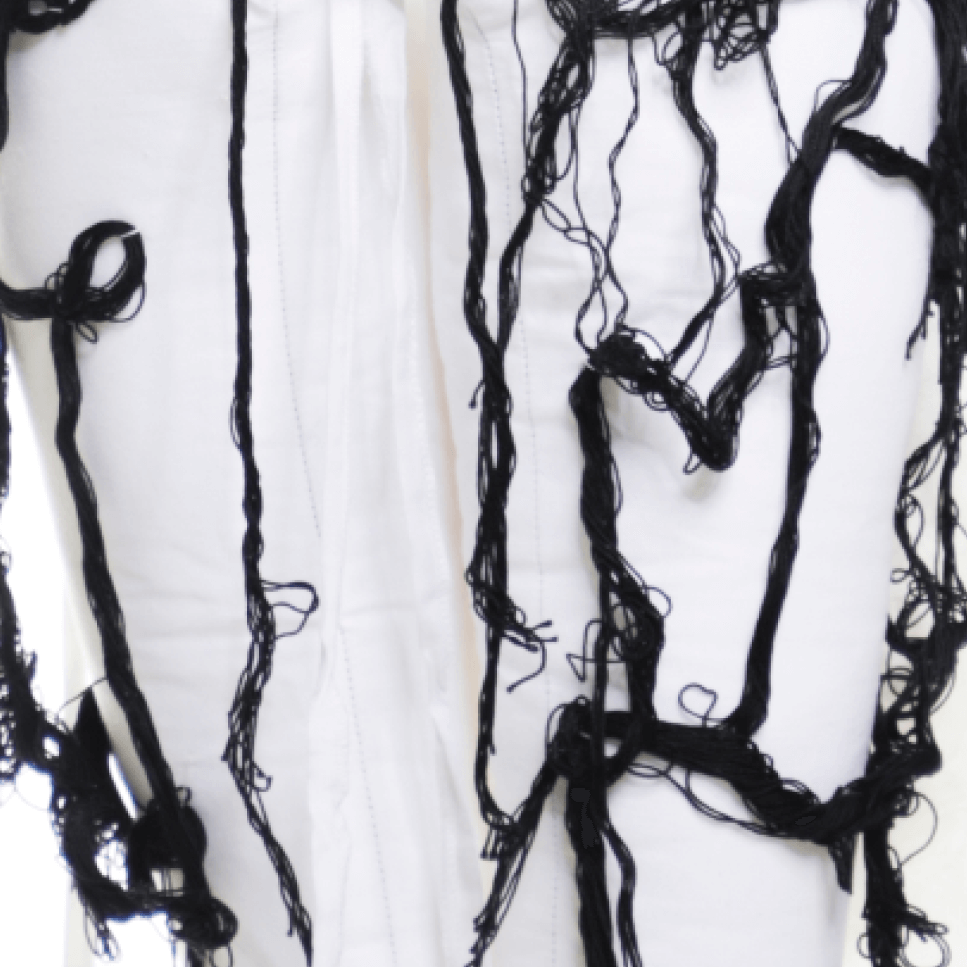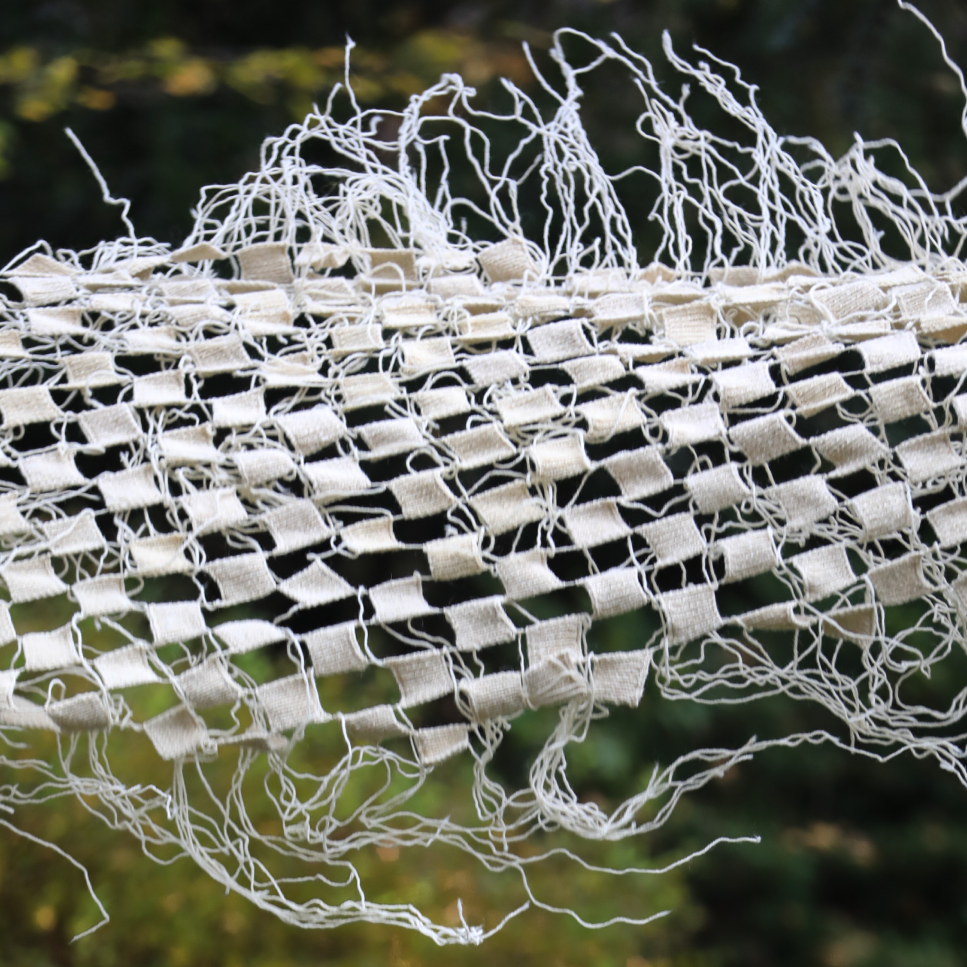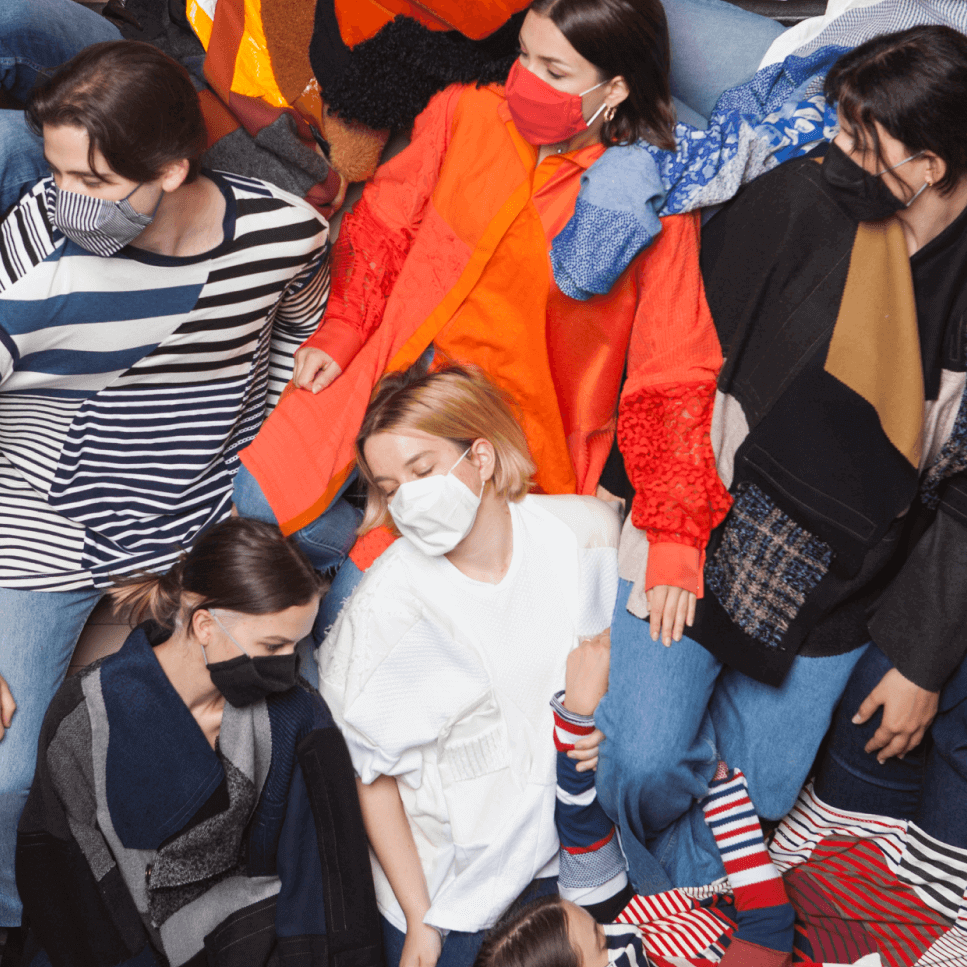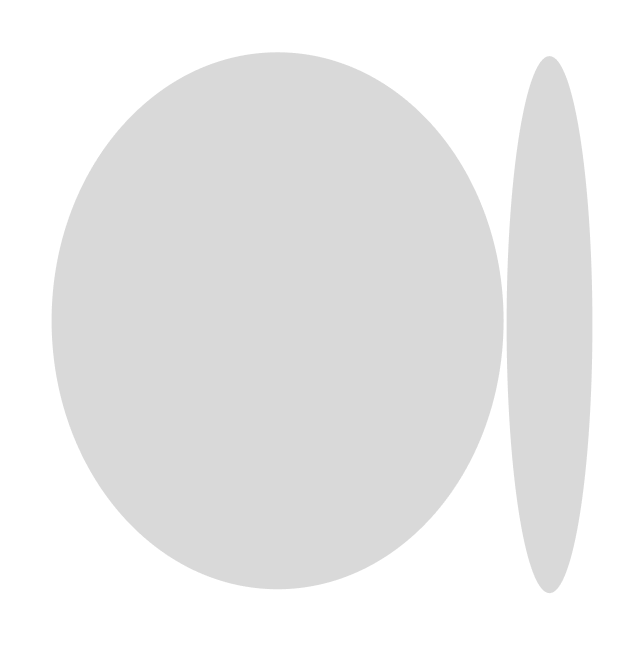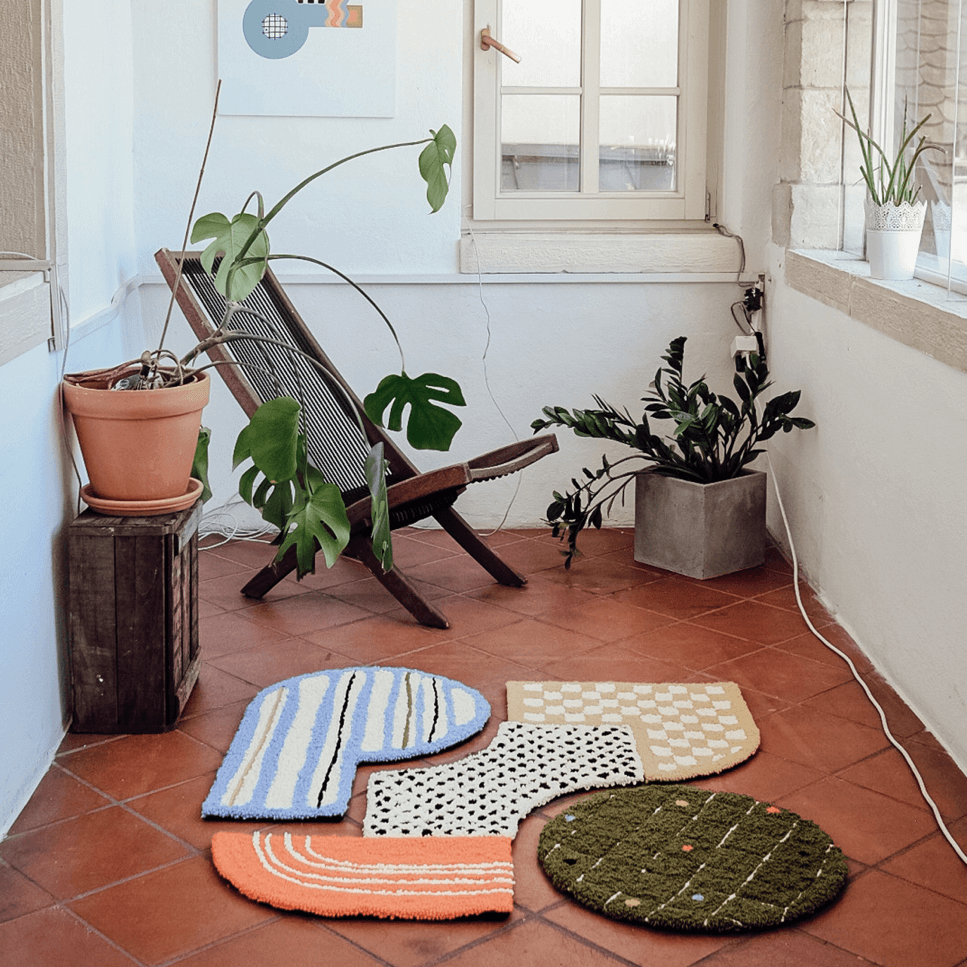IZKUŠNJA NE-SVOBODE KOT KREATIVNI POTENCIAL

asist. mag. Arijana Gadžijev
THE EXPERIENCE OF NON-FREEDOM AS CREATIVE POTENTIAL / Tch. Asst. Mag. Arijana Gadžijev
Nikoli ne bom pozabila trenutka, ko so nam med uro predmeta Oblikovanje tekstilij 1 sporočili, da bo treba iti domov, saj so začeli veljati ukrepi v zvezi s koronavirusom in okužbo covid-19. Na ta dan smo ravno razdeljevali male prenosne statve za ročno tkanje in dobila jih je le ena skupina študentov, druga skupina, ki bi statve prevzela naslednji dan, je ostala brez teh do konca šolskega leta.
Učilnice in studii so se prestavili za domače stene, računalniški ekran je postal okno v svet. Delo je začelo potekati precej drugače in tako mentorji kot študenti smo potrebovali kak teden dni, da smo se prilagodili na novo delovno okolje in ritem. Prosti čas se je prepletal z delom, varstvo otrok in skrb za (stare) starše ali druge družinske člane sta se prepletali s službo in študijem, meje so bile tako rekoč zabrisane.
Ob spremembi načina dela se je bilo treba znajti tudi na področju uporabe materialov in tehnik oblikovanja tekstilij, ki se jih študenti poslužujejo tekom procesa razvoja projekta. Ta izbira, ki je na fakulteti tako samoumevna, v pestrosti različnih strojev, naprav in orodji ter s fizično prisotnostjo mentorjev in sodelavcev, je postala precej okrnjena. V pomanjkanju izbir so študenti najprej začutili nemoč.
Vendar pa je ta drugačna situacija porodila nove kreativne ideje, nesvoboda je na nek način začela osvobajati. Študenti so postali bolj iznajdljivi in samoiniciativni, sami so na različne načine ustvarili orodja za oblikovanje tekstilij. Lesene prenosne statve je zamenjala stiroporna plošča z bucikami na zgornji in spodnji stranici, fino prejo za tkanje pa babičina volnena preja za pletenje ali narezana polivinilna vrečka. Paradoksalno se je z omejenostjo kreativnost še bolj razvijala, porabile so se surovine in materiali, ki so jih študenti našli doma v hiši, na vrtu ali v bližnjem gozdu, saj so bile trgovine zaprte.
Nove ideje so se hitro stopnjevale, se preoblikovale in postajale kvalitetne zasnove za izvedbo projektov. Ob tem so imeli nekateri študenti srečo, da so jim z znanji in spodbudami ter neposrednim zanimanjem za ročno delo pomagale tudi njihove družine. Ob delu in druženju so pridobili »stara« znanja starejših družinskih članov, ki so nekoč, v obdobju počasnejšega ritma življenja, znali združiti prijetno s koristnim ter tako šivali, kvačkali, vezli, tkali in pletli, zraven pa si pripovedovali marsikaj.
V vseh delih pa se je v tem pandemičnem obdobju kljub »starodavnim« ročnim tehnikam oblikovanja tekstilij neizprosno zrcalil zeitgeist. Občutki in vplivi trenutnega stanja so bili edina iskrena vsebina, prežeta z melanholijo po nedavnih časih, nostalgičnimi spomini iz otroštva ter vsemi prevpraševanji o prihodnosti.
V študentskih delih so začele odzvanjati drugačne zgodbe, zelo osebnoizpovedne. Ob omejenosti gibanja in potovanja po državi se je začelo raziskovanje domačega okolja. Gibanje in fizična aktivnost, sploh v naravi, je botrovala k še boljšemu razvoju idej in razmišljanju z drugačne perspektive. Študenti so ugotovili, da ne potrebujejo na novo kupljenih materialov, da jih precej lahko najdejo tudi na sprehodu ali med brskanjem po podstrešju, v kleteh in omarah.
V svoje projekte so začeli upeljevati pojem trajnosti in recikliranja. Izkušnja izolacije jih je naredila še bolj razmišljujoče, saj so preizkusili, kaj zares potrebujejo v življenju, kaj je lahko dovolj. Med našimi študenti in mlado tekstilno umetnico Erin McQuarrie (1), odkrito s strani slovite Lidewij Edelkoort (2), lahko potegnemo sorodno vzporednico. V letni reviji Talking Textiles (3) iz leta 2021 je opisano, kako se je Erin v svojem majhnem stanovanju v New Yorku, v času lockdowna, spopadala z osamljenostjo in na novo izumljala ročno tkanje, od samega pripomočka, torej ročnih statev, do materiala in končnega izdelka.
Bolj ko je preživljala težke čase med izolacijo, močnejša je bila njena želja po ustvarjanju. Šok pandemije je nekako spodbudil njeno ustvarjalnost in jo prisilil v ponovno rojstvo le-te. Z občutki svobode in navdušenja je oblikovala improvizirani prestol za tkanje, ki je nastal z ovijanjem, pretkanjem in kolažiranjem odpadnega tekstila (4). Erin je tako ustvarila ultimativni tkalski objekt – tkalski prestol, ki je postal pojem njene kreativne svobode v pandemičnem obdobju izolacije.
Dela naših študentov pa so s svojimi zgodbami močno zaznamovala prvi Bienale tekstilne umetnosti – BIEN 2021 (5) in napovedala spremembe v razmišljanju o trajnosti, dediščini in ohranjanju (6) – trojici besed, ki jih je v uvodniku prvega kataloga Bienala tekstilne umetnosti zapisala kreativna vodja in producentka bienala ter umetniška vodja Zavoda Carnica, Zala Orel, in ki so hkrati vodilo bienala.
Učilnice in studii so se prestavili za domače stene, računalniški ekran je postal okno v svet. Delo je začelo potekati precej drugače in tako mentorji kot študenti smo potrebovali kak teden dni, da smo se prilagodili na novo delovno okolje in ritem. Prosti čas se je prepletal z delom, varstvo otrok in skrb za (stare) starše ali druge družinske člane sta se prepletali s službo in študijem, meje so bile tako rekoč zabrisane.
Ob spremembi načina dela se je bilo treba znajti tudi na področju uporabe materialov in tehnik oblikovanja tekstilij, ki se jih študenti poslužujejo tekom procesa razvoja projekta. Ta izbira, ki je na fakulteti tako samoumevna, v pestrosti različnih strojev, naprav in orodji ter s fizično prisotnostjo mentorjev in sodelavcev, je postala precej okrnjena. V pomanjkanju izbir so študenti najprej začutili nemoč.
Vendar pa je ta drugačna situacija porodila nove kreativne ideje, nesvoboda je na nek način začela osvobajati. Študenti so postali bolj iznajdljivi in samoiniciativni, sami so na različne načine ustvarili orodja za oblikovanje tekstilij. Lesene prenosne statve je zamenjala stiroporna plošča z bucikami na zgornji in spodnji stranici, fino prejo za tkanje pa babičina volnena preja za pletenje ali narezana polivinilna vrečka. Paradoksalno se je z omejenostjo kreativnost še bolj razvijala, porabile so se surovine in materiali, ki so jih študenti našli doma v hiši, na vrtu ali v bližnjem gozdu, saj so bile trgovine zaprte.
Nove ideje so se hitro stopnjevale, se preoblikovale in postajale kvalitetne zasnove za izvedbo projektov. Ob tem so imeli nekateri študenti srečo, da so jim z znanji in spodbudami ter neposrednim zanimanjem za ročno delo pomagale tudi njihove družine. Ob delu in druženju so pridobili »stara« znanja starejših družinskih članov, ki so nekoč, v obdobju počasnejšega ritma življenja, znali združiti prijetno s koristnim ter tako šivali, kvačkali, vezli, tkali in pletli, zraven pa si pripovedovali marsikaj.
V vseh delih pa se je v tem pandemičnem obdobju kljub »starodavnim« ročnim tehnikam oblikovanja tekstilij neizprosno zrcalil zeitgeist. Občutki in vplivi trenutnega stanja so bili edina iskrena vsebina, prežeta z melanholijo po nedavnih časih, nostalgičnimi spomini iz otroštva ter vsemi prevpraševanji o prihodnosti.
V študentskih delih so začele odzvanjati drugačne zgodbe, zelo osebnoizpovedne. Ob omejenosti gibanja in potovanja po državi se je začelo raziskovanje domačega okolja. Gibanje in fizična aktivnost, sploh v naravi, je botrovala k še boljšemu razvoju idej in razmišljanju z drugačne perspektive. Študenti so ugotovili, da ne potrebujejo na novo kupljenih materialov, da jih precej lahko najdejo tudi na sprehodu ali med brskanjem po podstrešju, v kleteh in omarah.
V svoje projekte so začeli upeljevati pojem trajnosti in recikliranja. Izkušnja izolacije jih je naredila še bolj razmišljujoče, saj so preizkusili, kaj zares potrebujejo v življenju, kaj je lahko dovolj. Med našimi študenti in mlado tekstilno umetnico Erin McQuarrie (1), odkrito s strani slovite Lidewij Edelkoort (2), lahko potegnemo sorodno vzporednico. V letni reviji Talking Textiles (3) iz leta 2021 je opisano, kako se je Erin v svojem majhnem stanovanju v New Yorku, v času lockdowna, spopadala z osamljenostjo in na novo izumljala ročno tkanje, od samega pripomočka, torej ročnih statev, do materiala in končnega izdelka.
Bolj ko je preživljala težke čase med izolacijo, močnejša je bila njena želja po ustvarjanju. Šok pandemije je nekako spodbudil njeno ustvarjalnost in jo prisilil v ponovno rojstvo le-te. Z občutki svobode in navdušenja je oblikovala improvizirani prestol za tkanje, ki je nastal z ovijanjem, pretkanjem in kolažiranjem odpadnega tekstila (4). Erin je tako ustvarila ultimativni tkalski objekt – tkalski prestol, ki je postal pojem njene kreativne svobode v pandemičnem obdobju izolacije.
Dela naših študentov pa so s svojimi zgodbami močno zaznamovala prvi Bienale tekstilne umetnosti – BIEN 2021 (5) in napovedala spremembe v razmišljanju o trajnosti, dediščini in ohranjanju (6) – trojici besed, ki jih je v uvodniku prvega kataloga Bienala tekstilne umetnosti zapisala kreativna vodja in producentka bienala ter umetniška vodja Zavoda Carnica, Zala Orel, in ki so hkrati vodilo bienala.
OPOMBE:
1. Erin McQuarrie je škotska umetnica in raziskovalka, ki raziskuje potencial tekstilnih tehnik in materialov za ustvarjanje prostora za novo raziskovanje in pripovedovanje zgodb. Njeno delo je dostopno na: https://www.erinmcquarrie.com/
2. Lidewij Edelkoort je svetovno priznana napovedovalka trendov. Več o njej in njenih tekstih o trendih, oblikovanju pa tudi vlogi rokodelstva v sodobnem času si lahko preberemo na njeni socialnomedijski platformi: http://www.edelkoort.com/trendtablet/
3. Talking Textiles je letna tiskana revija newyorškega meseca tekstilij (New York Textile Month), dostopno na: https://talkingtextilesmag.com/about
4. Edelkoort, Lidewij, Erin's errands, letna edicija revije Talking Textiles, 6. številka, v okviru 6. newyorškega meseca tekstilij (New York Textile Month), september 2021, dostopno na: https://www.edelkoort.com/shopping/sample-product/talking-textiles-6/
5. Bienale tekstilne umetnosti – BIEN je prostor, kjer BIEN-ovi umetniki in kuratorji s pomočjo tekstila in zaradi tekstila razmišljajo o trajnosti, dediščini in ohranjanju. Združujejo se v projektih, ki ozaveščajo o krožnem gospodarstvu, kulturni dediščini in okoljskih vprašanjih, dostopno na: https://layer.si/bien/
6. Orel, Zala, Trajnost tekstila, katalog Bienala tekstilne umetnosti, Layerjeva založba, Kranj, str. 7–8
LITERATURA:
1. Edelkoort, Lidewij, Erin's errands, Talking Textiles, Lidewij Edelkoort, številka 6, oktober 2021
2. BIEN 2021 – Bienale tekstilne umetnosti, katalog, Layerjeva založba, Kranj, maj 2021
1. Erin McQuarrie je škotska umetnica in raziskovalka, ki raziskuje potencial tekstilnih tehnik in materialov za ustvarjanje prostora za novo raziskovanje in pripovedovanje zgodb. Njeno delo je dostopno na: https://www.erinmcquarrie.com/
2. Lidewij Edelkoort je svetovno priznana napovedovalka trendov. Več o njej in njenih tekstih o trendih, oblikovanju pa tudi vlogi rokodelstva v sodobnem času si lahko preberemo na njeni socialnomedijski platformi: http://www.edelkoort.com/trendtablet/
3. Talking Textiles je letna tiskana revija newyorškega meseca tekstilij (New York Textile Month), dostopno na: https://talkingtextilesmag.com/about
4. Edelkoort, Lidewij, Erin's errands, letna edicija revije Talking Textiles, 6. številka, v okviru 6. newyorškega meseca tekstilij (New York Textile Month), september 2021, dostopno na: https://www.edelkoort.com/shopping/sample-product/talking-textiles-6/
5. Bienale tekstilne umetnosti – BIEN je prostor, kjer BIEN-ovi umetniki in kuratorji s pomočjo tekstila in zaradi tekstila razmišljajo o trajnosti, dediščini in ohranjanju. Združujejo se v projektih, ki ozaveščajo o krožnem gospodarstvu, kulturni dediščini in okoljskih vprašanjih, dostopno na: https://layer.si/bien/
6. Orel, Zala, Trajnost tekstila, katalog Bienala tekstilne umetnosti, Layerjeva založba, Kranj, str. 7–8
LITERATURA:
1. Edelkoort, Lidewij, Erin's errands, Talking Textiles, Lidewij Edelkoort, številka 6, oktober 2021
2. BIEN 2021 – Bienale tekstilne umetnosti, katalog, Layerjeva založba, Kranj, maj 2021
I will never forget when, during the Textile Design 1 course, we were told that we needed to go home as the measures related to the coronavirus and COVID-19 infection had come into effect. We distributed small portable looms for hand weaving that day, and only one group of students received them. The other group, which was supposed to receive them the next day, was left without them until the end of the school year.
Classrooms and studios moved behind the walls of homes; the computer screen became a window to the world. The ongoing work started to look much different, and it took both the mentors and the students about a week to adapt to the new work environment and rhythm. Free time was intertwined with work. Childcare and care for (grand) parents or other family members were intertwined with work and studies; the boundaries were practically blurred. With the change in the way of working, it was also necessary to find solutions regarding the use of materials and textile design techniques that students employ during the project development process.
This choice, so simple at the faculty, with various machines, devices and tools, and with the physical presence of mentors and colleagues, became quite limited. In the absence of options, students initially felt powerless. However, this different situation gave birth to new creative ideas; in a way, non-freedom began to liberate. Students became more resourceful and took the initiative to create various tools for textile design on their own.
Wooden portable looms were replaced by Styrofoam boards with pins on the top and bottom, and fine weaving yarn was replaced with grandma’s wool yarn or cut-up plastic bags. Paradoxically, with the limitations, creativity flourished even more; raw materials and materials students found at home, in the garden, or in the nearby forest were used as stores were closed. New ideas quickly escalated, transformed and became quality designs for project implementation. Some students were fortunate to have their families help them with knowledge, encouragement and interest in handwork.
Through work and socialising, they gained “old” knowledge from older family members who once, in a period of a slower pace of life, knew how to combine the pleasant with the useful, and thus sewed, crocheted, embroidered, woven and knitted, all while sharing stories. In all works, in this pandemic period, despite the “ancient” hand techniques of textile design, the zeitgeist was relentlessly mirrored. Feelings and influences of the current situation were the only sincere content, imbued with melancholy for past times, nostalgic childhood memories and all questions about the future.
Different, very personal stories began to resonate in student works.
With limited movement and travel within the country, exploration of the local environment began. Physical activity, especially in nature, contributed to even better development of ideas and thinking from a different perspective. Students realised they didn’t need newly purchased materials; they could also find them on a walk or while exploring the attic, cellar and closets.
They began to introduce the concept of sustainability and recycling into their projects. The experience of isolation made them more reflective as they tested what they truly need in life, what is sufficient. We can draw a parallel between our students and the young textile artist Erin McQuarrie (1), who was discovered by the famous Lidewij Edelkoort (2). In the 2021 edition of Talking Textiles (3), it is described how in her small apartment in New York, during the lockdown, Erin coped with loneliness and reinvented hand weaving, from the very device, i.e. the handloom, to the material and the finished product.
The more difficult times she experienced during isolation, the stronger her desire to create became. The shock of the pandemic somehow stimulated her creativity and forced its rebirth. With feelings of freedom and joy, she created an improvised weaving throne, which was made by wrapping, interweaving, and collaging textile waste (4). Thus, Erin created the ultimate weaving object – a weaving throne, which became a symbol of her creative freedom during the pandemic isolation. Our students’ works and stories strongly marked the first Textile Art Biennial – BIEN 2021 and heralded changes in thinking about sustainability, heritage and preservation. These three words were also written in the introduction of the first catalogue of the Textile Art Biennial by the head of the BIEN Biennale and artistic director of the Layer House, as well as the artistic director of Carnica Institute, Zala Orel, and they serve as a guiding principle for the biennial.
FOOTNOTES:
1. Erin McQuarrie is a Scottish artist and researcher who explores the potential of textile techniques and materials to create space for new exploration and storytelling. Her work is accessible at: https://www.erinmcquarrie.com/
2. Lidewij Edelkoort is a world-renowned trend forecaster. You can read more about her and her texts about trends, design and the role of craftsmanship in modern times on her social media platform: http://www.edelkoort.com/trendtablet/
3. Talking Textiles is the annual print magazine of New York Textile Month, accessible at https://talkingtextilesmag.com/about
4. Edelkoort, Lidewij, Erin’s errands, annual issue Talking Textiles, Issue 6, as part of 6th New York Textile Month, September 2021, accessible at: https://www.edelkoort.com/shopping/sample-product/talking-textiles-6/
5. Textile Art Biennial – Sustainability, heritage and preservation are thought of by BIEN artists and curators through textiles. They come together in projects that raise awareness of the circular economy, cultural heritage and environmental issues, accessible at https://layer.si/bien/
6. Orel, Zala, Durability of textiles, CATALOGUE BIEN 2021, Layer Publishing, Kranj, 7-8
BIBLIOGRAPHY:
1. Edelkoort, Lidewij, Erin’s errands, Talking Textiles, Lidewij Edelkoort, Issue 6, October 2021
2. BIEN 2021 – Bienale tekstilne umetnosti, katalog, Layerjeva založba, Kranj, May 2021
Classrooms and studios moved behind the walls of homes; the computer screen became a window to the world. The ongoing work started to look much different, and it took both the mentors and the students about a week to adapt to the new work environment and rhythm. Free time was intertwined with work. Childcare and care for (grand) parents or other family members were intertwined with work and studies; the boundaries were practically blurred. With the change in the way of working, it was also necessary to find solutions regarding the use of materials and textile design techniques that students employ during the project development process.
This choice, so simple at the faculty, with various machines, devices and tools, and with the physical presence of mentors and colleagues, became quite limited. In the absence of options, students initially felt powerless. However, this different situation gave birth to new creative ideas; in a way, non-freedom began to liberate. Students became more resourceful and took the initiative to create various tools for textile design on their own.
Wooden portable looms were replaced by Styrofoam boards with pins on the top and bottom, and fine weaving yarn was replaced with grandma’s wool yarn or cut-up plastic bags. Paradoxically, with the limitations, creativity flourished even more; raw materials and materials students found at home, in the garden, or in the nearby forest were used as stores were closed. New ideas quickly escalated, transformed and became quality designs for project implementation. Some students were fortunate to have their families help them with knowledge, encouragement and interest in handwork.
Through work and socialising, they gained “old” knowledge from older family members who once, in a period of a slower pace of life, knew how to combine the pleasant with the useful, and thus sewed, crocheted, embroidered, woven and knitted, all while sharing stories. In all works, in this pandemic period, despite the “ancient” hand techniques of textile design, the zeitgeist was relentlessly mirrored. Feelings and influences of the current situation were the only sincere content, imbued with melancholy for past times, nostalgic childhood memories and all questions about the future.
Different, very personal stories began to resonate in student works.
With limited movement and travel within the country, exploration of the local environment began. Physical activity, especially in nature, contributed to even better development of ideas and thinking from a different perspective. Students realised they didn’t need newly purchased materials; they could also find them on a walk or while exploring the attic, cellar and closets.
They began to introduce the concept of sustainability and recycling into their projects. The experience of isolation made them more reflective as they tested what they truly need in life, what is sufficient. We can draw a parallel between our students and the young textile artist Erin McQuarrie (1), who was discovered by the famous Lidewij Edelkoort (2). In the 2021 edition of Talking Textiles (3), it is described how in her small apartment in New York, during the lockdown, Erin coped with loneliness and reinvented hand weaving, from the very device, i.e. the handloom, to the material and the finished product.
The more difficult times she experienced during isolation, the stronger her desire to create became. The shock of the pandemic somehow stimulated her creativity and forced its rebirth. With feelings of freedom and joy, she created an improvised weaving throne, which was made by wrapping, interweaving, and collaging textile waste (4). Thus, Erin created the ultimate weaving object – a weaving throne, which became a symbol of her creative freedom during the pandemic isolation. Our students’ works and stories strongly marked the first Textile Art Biennial – BIEN 2021 and heralded changes in thinking about sustainability, heritage and preservation. These three words were also written in the introduction of the first catalogue of the Textile Art Biennial by the head of the BIEN Biennale and artistic director of the Layer House, as well as the artistic director of Carnica Institute, Zala Orel, and they serve as a guiding principle for the biennial.
FOOTNOTES:
1. Erin McQuarrie is a Scottish artist and researcher who explores the potential of textile techniques and materials to create space for new exploration and storytelling. Her work is accessible at: https://www.erinmcquarrie.com/
2. Lidewij Edelkoort is a world-renowned trend forecaster. You can read more about her and her texts about trends, design and the role of craftsmanship in modern times on her social media platform: http://www.edelkoort.com/trendtablet/
3. Talking Textiles is the annual print magazine of New York Textile Month, accessible at https://talkingtextilesmag.com/about
4. Edelkoort, Lidewij, Erin’s errands, annual issue Talking Textiles, Issue 6, as part of 6th New York Textile Month, September 2021, accessible at: https://www.edelkoort.com/shopping/sample-product/talking-textiles-6/
5. Textile Art Biennial – Sustainability, heritage and preservation are thought of by BIEN artists and curators through textiles. They come together in projects that raise awareness of the circular economy, cultural heritage and environmental issues, accessible at https://layer.si/bien/
6. Orel, Zala, Durability of textiles, CATALOGUE BIEN 2021, Layer Publishing, Kranj, 7-8
BIBLIOGRAPHY:
1. Edelkoort, Lidewij, Erin’s errands, Talking Textiles, Lidewij Edelkoort, Issue 6, October 2021
2. BIEN 2021 – Bienale tekstilne umetnosti, katalog, Layerjeva založba, Kranj, May 2021

